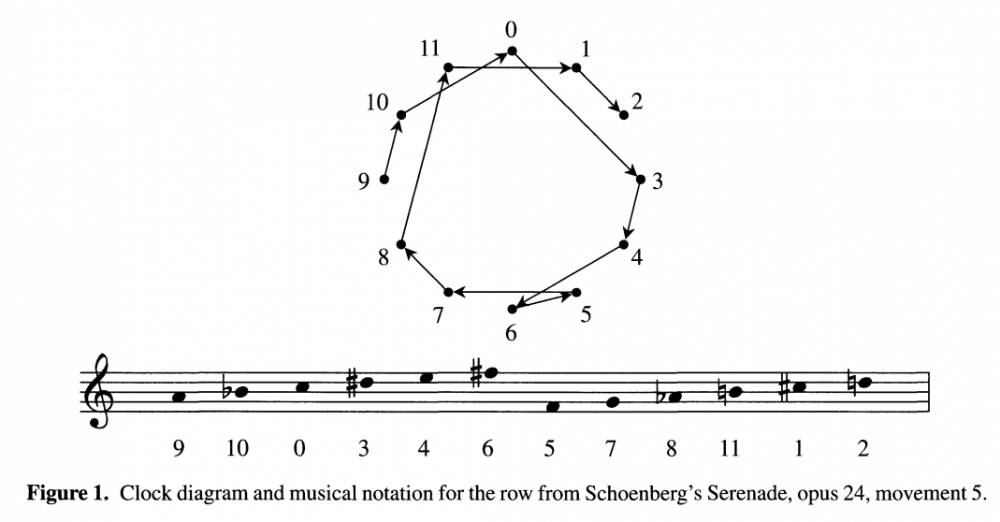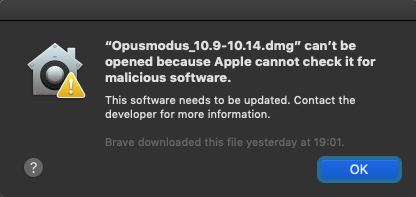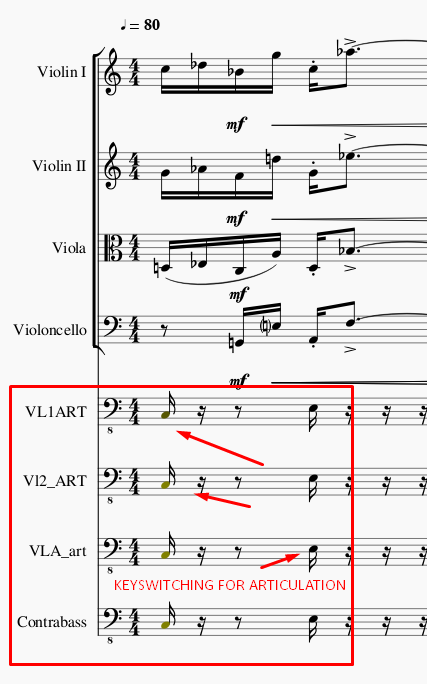Search the Community
Showing results for tags 'resolved'.
-
Dear All, I´m looking for a way to plot some graphs like these, showing 12 tone row ordering: I think that a function like this would be easy to program and adapt from the library. I don´t if there exist already something similar... It´s useful to show properties of 12 tone sets, like Tropes, simmetry relations, geometric operations. Best ! Julio How Rare Is Symmetry in Musical 12-Tone Rows? on JSTOR WWW.JSTOR.ORG David J. Hunter, Paul T. von Hippel, How Rare Is Symmetry in Musical 12-Tone Rows?, The American Mathematical Monthly, Vol. 110, No. 2 (Feb., 2003), pp. 124-132 HERE !!! FOUND !! (circle-pitch-plot '(0 2 6 0 3 7 0 4 8) :sort nil :point-radius 6)
-
Greetings from Finland, new Opusmodus user here... How do I get my serial number / license information to register my copy of Opusmodus? I purchased it today but didn't get any information via email nor can I find it under my profile/settings... Thanks.
-
Hi. I downloaded fresh from the website the 2.2 update and attempted to install. It failed the "malicious software" check and exits. Not so good. Any thoughts/solutions? This is on Mojave (10.14.6) where 2.1 installs fine. TIA ..mark.
-
Dear friends, A cool idea to implement would be to have a gen-divide like function for dividing rhythm lists, filtering just the positive values, like this: (setf rhy '(q -q -e e e e q q -s s s s)) ;;;Standard gen divide (gen-divide 3 rhy) ;;result: (q -q -e) (e e e) (q q -s) (s s s) ;;; (gen-divide-attack 3 rhy) ;;;result (q -q -e e e) (e q q) (-s s s s) To me, would be very useful. All the best ! Julio
- 6 replies
-
- gen-divide
- rhythm
-
(and 1 more)
Tagged with:
-
Dear all Is there some way to make a processing of accidentals in the make-omn expression or even later, in the PS expression ? Something like: bar #1 all sharps bar#2 all flats etc. I noticed that after many sucessive list processing, my original notes were altered. Thanks ! Best ! Julio
- 7 replies
-
- enharmonics
- flats
-
(and 2 more)
Tagged with:
-
If I don't want to have octaves, what shall I do? If I evaluate that code, I still get an octave. (setf v1 '(h c5)) (setf v2 '(-q c4)) (polyphony '((12 11)) (list v1 v2) :index 'out) (ps 'gm :p (list out1 out2)) Thank you. René Wohlhauser
-
Dear Friends, I have this recurrent problem with lists... Please, help... ;;; I have this TWO lists (setf list1 '(v1rp0 v1rp1 v1rp2 v1rp3 v1rp4) (setf list2 '(melch1-0 melch1-1 melch1-2 melch1-3 melch1-4) ;;;AND ;;; I need a list like this (alternating the list) (v1rp0 melch1-0 v1rp1 melch1-1 v1rp2 melch1-2 v1rp3 melch1-3 v1rp4 melch1-4) How can I proceed ? Thanks a lot Best, Julio (a desperate quarantine composer) OBS. help in combining THREE lists are also greatly appreciated, as well as how to combine parts of the lists. Thank you... my brain is ruined for now (I´m doing something BIG... ) All the best ! Julio
-
Dear All, I'm searching ways of making lists of lists. I tried all this because I was wanting to call materials from an array, like this: (setf mat1 '(c4 d4 ds7)) (setf mat2 '(d4 e4 c5)) (setf mat3 '(d4 eb4 cs5)) (setf mat4 '(d4 f4 c5)) (setf mat5 '(d4 g4 c5)) (setf mat6 '(d4 a4 c5)) (setf mat7 '(e4 a4 c5)) (setf mat8 '(f4 a4 c5)) (setf mat9 '(g4 a4 c5)) (setf mat10 '(a4 a4 c5)) (setf mat11 '(b4 a4 c5)) (setf array (build-array '((mat0 mat1 mat2 mat3) (mat4 mat5 mat6 mat7) (mat8 mat9 mat10 mat11)))) ;;;GET-ARRAY : (ROW COLUMN SIZE ARRAY &KEY DIRECTION (get-array 0 1 2 array :direction 'down) (setf listmat (get-array 0 1 2 array :direction 'down)) (list listmat) ; this does not work ; the result should be (list mat1 mat5) ((c4 d4 ds7) (d4 g4 c5)) What I did wrong ? Thanks in advance
-
Hi, Why does the first example work and the second don't, what am I missing? Thanks! (setf eins '((q d4 e4 fs4 gs4) (q d4 e4 fs4 gs4) (q d4 e4 fs4 gs4))) (unfold 'om '((pause 2)) eins) => ((q d4 e4 fs4 gs4) (-w) (q d4 e4 fs4 gs4)) (unfold 'om '((pause 2 2)) eins) => ((q d4 e4 fs4 gs4) (q d4 mf e4 fs4 gs4) (q d4 e4 fs4 gs4))
-
Dear Friends, After some time I managed to work with custom articulations, using the def-instruments folder, etc. This is working great ! No problem (thanks Janusz and Stephane for the support and tips). The question for me now is that I use to go back and forth to Opus Modus, Musescore (or Finale) and to my DAW (Bandlab) to work on sections, fine tuning notation, etc. So, in DAW or musescore, I use a setup like this: I have four instruments and more four additional staves just for articulation switching. THE QUESTION : Is there some way to export from Opusmodus as XML my score with the four instrument staves and more four staves with the exact key switches opusmodus are sending to the DAW ? In this way I could just import the XML file to my DAW or Musescore and I could hear it exactly like when previewing in Opusmodus and I also could manage to edit and refine my score at notation program or sequencer. Thanks a lot ! Best, Julio
-
Hi Opmo - Am having trouble accessing the Templates when starting a New file. The submenus appear, (Band, Chamber Groups etc) but the templates themselves (Brass Choir etc) appear greyed out and will not load. Have I inadvertently messed with my directory structure? How can I bring them back? thanks, Peter Measroch (edesert) Hi Opmo - you can ignore this post. I just realized I have to first open a new workspace before being able to access the individual templates. Sorry to bother! Peter
-
Good evening, I am currently using Opusmodus 2.1 in MacOS Catalina and it is working very well for me. Will this version of Opusmodus be compatible with MacOS Big Sur 11.01? Any guidance that you can provide will be greatly appreciated. Best regards, Eric
-
Hi, Is it possible to change the offset from find-everyother somehow? (find-everyother 2 '(1 2 3 4 5 6)) --> (1 3 5) like this: (find-everyother 2 '(1 2 3 4 5 6) :offset 1) --> (2 4 6) thanks!
-
Hi, is there a print function for the midi display? At the moment I am using "zoom to fit" in fullscreen mode and then make a screenshot but this is a little cumbersome ... Achim
-
Opusmodus 1.2 can be used from within the Emacs editor as well (see the post at the link below for details). For me as a programmer having additionally access to the Emacs Lisp IDE SLIME is greatly preferable due to various advanced features provided by Slime when compared with the more easy-to-use native IDE of Opusmodus. For more information on SLIME see its website: https://common-lisp.net/project/slime Unfortunately, the SLIME link is seemingly broken in Opusmodus 1.3, which I just started for the first time. For those who have no SLIME installed (but have Quicklisp set up), SLIME can be installed with the following command. (ql:quickload "quicklisp-slime-helper") Unfortunately, this results now in an error. To load "quicklisp-slime-helper": Load 1 ASDF system: quicklisp-slime-helper ; Loading "quicklisp-slime-helper" .. > Error: Undefined function asdf/interface::operation-forced called with arguments (#<load-op>) . > While executing: #<standard-method asdf/action:perform (asdf/lisp-action:load-op swank-loader::swank-loader-file)>, in process Listener-2(9). > Type cmd-/ to continue, cmd-. to abort, cmd-\ for a list of available restarts. > If continued: Retry applying asdf/interface::operation-forced to (#<load-op>). > Type :? for other options. I already had SLIME installed, but simply running it does not work either and results in the same error. (cl-user::start-swank) ? To load "swank": Load 1 ASDF system: swank ; Loading "swank" . > Error: Undefined function asdf/interface::operation-forced called with arguments (#<load-op>) . > While executing: #<standard-method asdf/action:perform (asdf/lisp-action:load-op swank-loader::swank-loader-file)>, in process Listener-2(9). > Type cmd-/ to continue, cmd-. to abort, cmd-\ for a list of available restarts. > If continued: Retry applying asdf/interface::operation-forced to (#<load-op>). > Type :? for other options. Any help? Thanks a lot! Best, Torsten
-
Hello, I'm continually receiving the following error on start up: Opusmodus Extension Initialization(5) > Error: Undefined function setup-ins called with arguments ("add" "addflt" "addsnd" "anoi" "arith" "arith1" "arith2" "autoc" "backandforth" "badd" "bandedwg" "bell" "bigbird" "bird" "bowl" "btest" "canter" "cellon" "circular-scanned" "cnv" ...) . > While executing: (:internal ccl::with-compilation-unit-body ccl::load-from-stream), in process Opusmodus Extension Initialization(5). > Type cmd-/ to continue, cmd-. to abort, cmd-\ for a list of available restarts. > If continued: Retry applying setup-ins to ("add" "addflt" "addsnd" "anoi" "arith" "arith1" "arith2" "autoc" "backandforth" "badd" "bandedwg" "bell" "bigbird" "bird" "bowl" "btest" "canter" "cellon" "circular-scanned" "cnv" ...). > Type :? for other options. 1 > . This was since upgrading to 2.0. Is there something I need to correct in my installation? Thank you.
-
I just discovered that (from the doc for integer-to-pitch) (integer-to-pitch '((-2 -1) 0 (1 2))) => (bb3b3 c4 cs4d4) but (integer-to-pitch '((-2 -1) (0 2) (1 2))) => ((bb3 b3) (c4 d4) (cs4 d4)) Unless at least one element is not a sublist, it fails to make chords. This seems inconsistent, and probably a bug. This is in Opusmodus Version 1.3.24962
-
It would be great if the File / Open Recent... list was sub-divided into .opmows files and everything else. It would also be very convenient if, when Opusmodus starts, it re-opened any .opmows files that were open when it last quit, but lacking that, having a separate section for them in Open Recent... would provide quick access to what I've been working on. As-is, any .opmows file tends to fall off the list when I open enough other files.
-
I've attached two screenshots showing how Figure 10 in "1st Element - Length.rtfd" looks, compared to the example copied to the left pane and evaluated using Tools / Snippet / OMN Notation. I would much prefer the appearance of the tutorial example, without the horizontal line, to what I get when I render it. Is there a problem with my setup, a bug, or has an aesthetic decision been made here that didn't get reflected in the doc? I'm using OM Version 1.3.24952 on MacOSX 10.14.6. Thanks for any insights.
-
resolved Lisp function for stopping playback?
torstenanders posted a topic in Support & Troubleshooting
What is the Lisp function for stopping playback (bound to the shortcut cmd-esc)? ... I could never add a custom keyboard shortcut to the Opusmodus text editor Hemlock (and I tried), but I just managed adding keyboard shortcuts and a menu for playing Opusmodus snippets and my polyphonic score format to Emacs (thanks to the fact that scores now can be displayed in a separate window). Only need some key for stopping playback as well. (The main thing I will then miss when using Emacs as the Opusmodus IDE is the close integration of the document, but well, you cannot have everything On the plus side, I have a more stable editor and in particular a very good debugger.) Thanks! Torsten -
Common Music (CM) is another interesting composition system (http://commonmusic.sourceforge.net), and a recent revision of the old CM version 2 (https://github.com/ormf/cm), which was still implemented in Common Lisp (in contrast to later versions defined in Scheme) can be loaded into and used alongside Opusmodus 1.2 without problems. This was possible primarily due to a largely revised load mechanism of the old CM sources. With the new Opusmodus 1.3 this is not possible any more. It seems the problem is caused by the fact that :CLM (and a number of variants) are still added to *features*, but there is no CLM package anymore. I cannot see the Opusmodus sources, but I assume that all CLM definitions have been added directly to the Opusmodus package. Anyway, due to the present feature CM assumes that CLM is there, but then cannot find its package. Anyway, I found a way around (by changing the relevant feature expressions from #-clm into #-(and clm (not opusmodus)) and will try to have that included in the relevant CM sources at https://github.com/ormf/cm Best, Torsten
-
Hallo, newbie here I'm just starting with OM and playing around with the tutorials. I slightly changed tutorial #4 and run into something strange. If i run the script as posted below, all works as expected. But when i change the function reverse to nreverse (and nreverse is the oficially documented name of the function) the omn result will leave the right hand empty. Why ist that? And why does reverse work as i expect it to work? And, another thing: i dont understand what the term seed will do. Will it make random functions behave always the same as long as the seed is the same? ...and what does the number following the seed mean? Thank you !! Best, Sebasian (setf pitches (gen-repeat 5 '(c4 cs4 fs4 g4 c5 cs5))) (setf transposed-pitches (gen-repeat 5 (pitch-transpose -24 pitches))) (setf lengths (span pitches '(e))) (setf lengths-rests (length-weight lengths :weight '(2 1) :seed 12)) (setf left-lengths (reverse lengths-rests)) (setf piano-righthand (make-omn :length lengths-rests :pitch pitches :velocity'(mp))) (setf piano-lefthand (make-omn :length left-lengths :pitch transposed-pitches :velocity '(f))) (setf timesigs (get-time-signature left-lengths)) (def-score lesson-4 (:key-signature 'chromatic :time-signature '( 5 8 ) :tempo 190 :layout (piano-layout 'piano-rh 'piano-lh)) (piano-rh :omn piano-righthand :channel 1 :sound 'gm :program 'acoustic-grand-piano) (piano-lh :omn piano-lefthand) )
- 2 replies
-
- seed
- gen-retrograde
-
(and 2 more)
Tagged with:
-
Hi, I am getting back to Opusmodus after a long time. I am excited about the support for OSC in this new release. I have two questions: 1) Normally when we use OSC to send to a destination, we use an "address" like "/a/b/c". A device that has this destination "address" is expected to receive the message and act on it. How and where do we specify that address in "osc-thread" function. Just to give an example, a couple of years ago, I had written an article on how to control Reaktor using OSC. If I want to do something similar using OM, what is the procedure? 2) There could be occasions where I want to ping the destination at regular intervals. How do I do that in OM? A detailed example will be quite useful. Regards, Rangarajan
-
Dear Friends, I'm happy to announce that my doctoral dissertation in music composition will have many Opusmodus examples ! I'd like to know how the best way to export plots, and midi piano roll (assistants) for using as examples in Microsoft Word, PDF applications, vectorial graphic software (like Corel), etc I was just snapshoting the screen with built in mac snapshot function (CMN + CTRL + SHIFT + 4) but wondering if there are some method for saving the output. Best, Julio
- 12 replies








